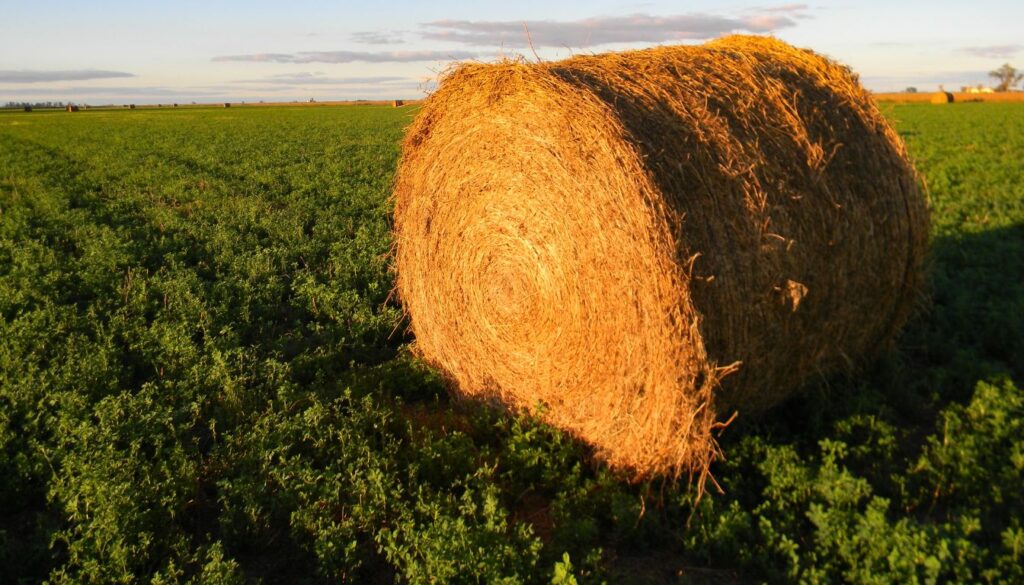If you’re looking to boost your farm’s productivity and sustainability, growing alfalfa hay might just be your best bet. This nutrient-rich forage is a favorite among livestock and can significantly enhance your bottom line. Imagine your animals thriving on high-quality feed while you enjoy the benefits of a more profitable operation.
Alfalfa is not just any crop; it’s a powerhouse that improves soil health and requires less water than you might think. Whether you’re a seasoned farmer or just starting, the rewards of cultivating alfalfa hay are immense. Ready to dig deeper into the world of alfalfa? Let’s explore how you can turn your fields into a lush, green haven that supports both your livestock and your financial goals.
Overview Of Growing Alfalfa Hay
Growing alfalfa hay is both rewarding and practical. I find that it’s a versatile crop that provides excellent forage for livestock. It thrives in well-drained soil, making it a great fit for many farms. When planted in the right conditions, alfalfa can deliver multiple harvests over a growing season.
I like to start with soil testing. This step identifies nutrient levels and pH. Alfalfa prefers a pH between 6.5 and 7.5. If the soil lacks essential nutrients, I add lime or fertilizers to boost fertility.
Planting alfalfa requires attention to timing. Ideally, I sow seeds in spring or late summer. The soil temperature should be at least 60°F for optimal germination. I follow up with adequate watering, especially during establishment, to ensure seedlings establish roots.
Harvesting alfalfa is key to maximizing quality. I wait until the bloom stage for the best nutrient balance. Cutting the hay at this time maximizes protein levels, enhancing its value as feed. After cutting, I allow the hay to dry before baling. It’s crucial to monitor moisture levels to prevent spoilage.
Managing pests and diseases involves regular scouting. I keep an eye out for common issues like aphids or fungal infections. Using integrated pest management techniques helps reduce chemical use while maintaining crop health.
By consistently caring for my alfalfa, I enjoy improved soil health and better livestock nutrition. The benefits extend beyond the field, enhancing my farm’s profitability and sustainability. Growing alfalfa hay isn’t just a task; it’s an investment in the future of my farming operation.
Benefits Of Growing Alfalfa Hay

Growing alfalfa hay offers significant advantages for farmers, enhancing both productivity and sustainability.
Nutritional Value – Grow Alfalfa Hay: Essential Tips to Boost Farm Productivity
Alfalfa hay provides livestock with essential nutrients. Packed with protein, fiber, vitamins, and minerals, it promotes optimal animal health. For example, it contains about 15-20% protein, which supports growth and milk production in dairy cattle. The high digestibility of alfalfa means animals absorb more nutrients, leading to better overall performance. When livestock consume alfalfa, they enjoy a balanced diet that maintains their energy levels and keeps them active. Happy animals equal happy farmers!
Economic Advantages
Growing alfalfa hay may boost farm profits. High-quality hay can fetch higher market prices, putting more money in your pocket. With multiple harvests each growing season, you maximize yield from each acre. Plus, alfalfa’s deep root system improves soil health, reducing the need for chemical fertilizers over time. That means lower input costs! Investing in alfalfa can lead to a robust return on investment, helping you finance that new tractor or family vacation you’ve been dreaming of.
Best Practices For Growing Alfalfa Hay
Growing alfalfa hay requires attention to detail and a few tried-and-true methods. Following best practices ensures high-quality yields and healthy plants.
Soil Preparation – Grow Alfalfa Hay: Essential Tips to Boost Farm Productivity
I always start with soil testing. Testing reveals nutrient levels and pH, guiding amendments to create the best environment for alfalfa. Ideal soil pH ranges from 6.5 to 7.5. I also focus on well-drained soil. Alfalfa dislikes sitting water; it thrives in good drainage. I incorporate organic matter, such as compost, to boost fertility. Proper soil preparation sets the stage for a successful crop.
Seeding Techniques
Timing is everything with seeding. I recommend planting in spring or late summer when soil temperatures reach at least 60°F. This ensures a quick germination process. I prefer using a no-till method, which minimizes soil disturbance and conserves moisture. Spacing the seeds properly allows for thick stands while reducing competition. An even distribution of seed makes all the difference, so I’m careful to follow the recommended rates.
Irrigation Methods
Irrigation plays a crucial role in alfalfa growth. I ensure consistent moisture, especially during the establishment phase. Drip irrigation works wonders for conserving water while preventing waterlogging. I monitor rainfall, adjusting irrigation schedules as needed. Alfalfa generally requires about 20-30 inches of water annually, but this can vary based on climate. I always prioritize efficient methods to keep my crop thriving while saving resources.
Common Challenges In Growing Alfalfa Hay
Growing alfalfa hay comes with its fair share of challenges. Recognizing these issues can help me manage my crops more effectively and boost my yields.
Pests And Diseases – Grow Alfalfa Hay: Essential Tips to Boost Farm Productivity
Pests can devastate alfalfa crops if I’m not careful. Aphids, spider mites, and root weevils are common culprits that can harm my plants. I must monitor my fields closely for these pests. Integrated pest management techniques work well for controlling their numbers. Using natural predators, like ladybugs, can keep pest populations in check. Diseases, such as root rot and powdery mildew, often thrive in damp conditions. Seasonal weather changes can make crops more susceptible. Regular inspections and timely applications of fungicides help keep my plants healthy.
Weather Conditions
Weather plays a significant role in growing alfalfa. Too much rain can saturate the soil and stunt growth, while drought can lead to wilting plants. I check the weather forecast regularly to plan my irrigation schedule. Alfalfa prefers well-drained soil and bright sunlight, so I choose the planting location wisely. Extremes in temperature can stress the plants. I should monitor the forecast, especially during critical growth periods, to protect my investment. When I grow alfalfa, I embrace its resilience, knowing it can adapt but still needs some elbow grease to thrive.
Before You Go – Grow Alfalfa Hay: Essential Tips to Boost Farm Productivity

Growing alfalfa hay is a smart choice for anyone looking to boost farm productivity and sustainability. With its rich nutritional profile and benefits for livestock health, it’s clear that alfalfa can be a game changer.
By following best practices like soil testing, proper planting timing and pest management, I can ensure a thriving crop that not only supports my animals but also enhances my bottom line.
As I invest time and resources into cultivating alfalfa, I’m confident that I’m making a valuable addition to my farming operation. With careful attention to detail and a commitment to sustainable practices, I can reap the rewards of this remarkable forage.
Don’t forget to add theherbprof.com homepage to your favourites so you don’t miss out on future articles.
References – Grow Alfalfa Hay: Essential Tips to Boost Farm Productivity
Little Herb Encyclopedia, by Jack Ritchason; N.D., Woodland Publishing Incorporated, 1995
The Ultimate Healing System, Course Manual, Copyright 1985, Don Lepore
Planetary Herbology, Michael Tierra, C.A., N.D., Lotus Press, 1988
Handbook of Medicinal Herbs, by James A. Duke, Pub. CRP Second Edition 2007
The Complete Medicinal Herbal, by Penelope Ody, Published by Dorling Kindersley
Check the Following Article
Arugula Indoors: Easy Tips to Grow Greens Year-Round
Sea Buckthorn Oil: Benefits for Healthy and Glowing Skin
Escallonia Plant: A Vibrant Addition to Your Garden
Caring for Potted Chrysanthemums: A Complete Guide
Frequently Asked Questions – Grow Alfalfa Hay: Essential Tips to Boost Farm Productivity
What are the benefits of growing alfalfa hay?
Growing alfalfa hay provides numerous benefits, including improved livestock health due to its high nutritional content. It enhances farm productivity and profitability, supports soil health, and has low water requirements, making it a sustainable choice for farmers.
How should I prepare my soil for alfalfa hay?
Soil preparation for alfalfa hay involves testing and amending the soil to achieve a pH between 6.5 and 7.5. Ensuring well-drained soil and following no-till seeding methods can enhance moisture retention and minimize soil disturbance for optimal growth.
When is the best time to plant alfalfa?
The best time to plant alfalfa is in the spring or late summer when soil temperatures are at least 60°F. This timing helps ensure successful germination and establishes strong growth for the crop.
How often can I harvest alfalfa hay?
Alfalfa hay can be harvested multiple times during a growing season, depending on environmental conditions and management practices. Harvesting often maximizes yield and maintains the quality of the forage.
What pests should I be aware of when growing alfalfa?
Common pests affecting alfalfa include aphids and spider mites. It’s important to monitor for these pests regularly and use integrated pest management techniques to control their populations and protect the crop.
What is the nutritional value of alfalfa hay?
Alfalfa hay is rich in protein, fiber, vitamins, and minerals, making it an excellent forage option for livestock. This rich nutrient profile promotes optimal animal health and improves overall farm productivity.
How does alfalfa hay impact soil health?
Alfalfa hay enhances soil health by fixing nitrogen, improving soil structure, and increasing organic matter. Healthy soil supports greater crop yields and can reduce the need for fertilizers, further benefiting sustainability.
What irrigation method is recommended for growing alfalfa?
Drip irrigation is recommended for growing alfalfa hay as it maintains moisture levels efficiently while conserving water resources. Regular irrigation is crucial, especially during the establishment phase.
How does weather affect alfalfa growth?
Weather can significantly impact alfalfa growth; excessive rain or drought can hinder development. Careful planning and monitoring of weather forecasts help protect crops during critical growth periods to ensure a successful harvest.

